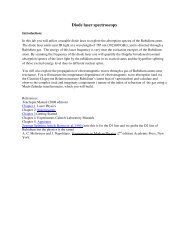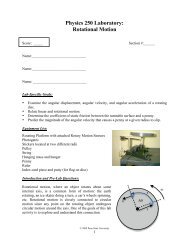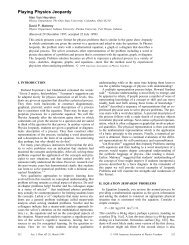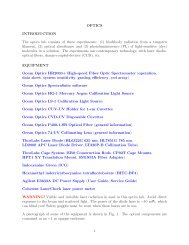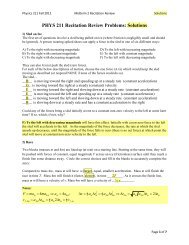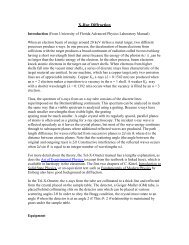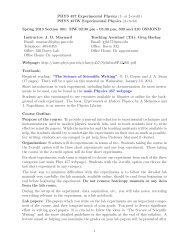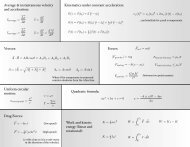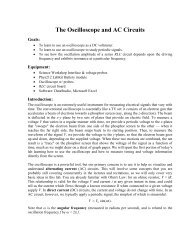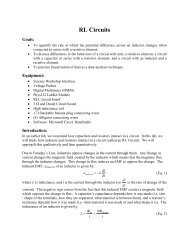PHYS 250 Recitation 14-Oscillations and Waves
PHYS 250 Recitation 14-Oscillations and Waves
PHYS 250 Recitation 14-Oscillations and Waves
You also want an ePaper? Increase the reach of your titles
YUMPU automatically turns print PDFs into web optimized ePapers that Google loves.
<strong>PHYS</strong> <strong>250</strong> <strong>Recitation</strong> #<strong>14</strong>: <strong>Oscillations</strong> & <strong>Waves</strong><br />
Any system for which the acceleration is linearly proportional to the position (with a negative<br />
proportionality constant), or<br />
a x = -ω 2 x,<br />
undergoes simple harmonic motion, a form of oscillatory motion. The mathematical solution 1 to<br />
this is:<br />
x(t) = A cos(ωt),<br />
where A is the amplitude <strong>and</strong> ω = 2πf = 2π/T is the angular frequency (f is the frequency in Hz<br />
<strong>and</strong> T is the period). For a mass on a spring, ω 2 = k/m; for a simple pendulum, ω 2 = g/L.<br />
A wave is just an oscillation that travels in space, so it oscillates in both space <strong>and</strong> time, or<br />
y(t) = A cos(kx - ωt),<br />
where the wavenumber k = 2π/λ, where λ is the wavelength. [This is for a wave moving in the<br />
+x direction. A wave moving in the –x direction would be A cos(kx + ωt).]<br />
The speed with which the wave travels through a medium is determined by the properties of the<br />
medium, not the wave itself. The speed of sound depends on pressure <strong>and</strong> density of the gas<br />
(both of which depend on temperature); we will use 343 m/s for sound in air as a typical value<br />
for this class. For a wave on a string, the wave speed is set by the tension (T s ) <strong>and</strong> the mass<br />
density (mass/length) µ of the string, or<br />
v 2 = T s /µ.<br />
A medium can support a spectrum of wavelengths <strong>and</strong> frequencies. For a traveling wave created<br />
by an object oscillating at a frequency f, then the wavelength of the wave is set by the wave<br />
speed <strong>and</strong> frequency through the relationship:<br />
v = λf.<br />
For a st<strong>and</strong>ing wave, the length <strong>and</strong> boundary conditions set the possible λs that can resonate in<br />
the system, <strong>and</strong> then the frequencies corresponding to these wavelengths are set by the same<br />
v = λf relationship. (For a string or open-open system, λ 1 = 2L; for open-closed, λ 1 = 4L.)<br />
1 Really, the solution is x(t) = Acos(ωt) + Bsin(ωt), which can also be written as x(t) = Acos(ωt<br />
+ φ), which we have just been using with B = 0 (or φ = 0) for simplicity.
<strong>Oscillations</strong> Problem. A 0.1 kg mass on a spring with k = 5 N/m is stretched from its<br />
equilibrium position by 15 cm <strong>and</strong> then released. Sketch the position versus time for this<br />
oscillator for 4 seconds. Be as quantitative <strong>and</strong> precise as possible <strong>and</strong> be sure to label your<br />
graph.<br />
Calculate the following quantities for this oscillator (be sure to specify units!)<br />
Amplitude A = ___________________<br />
Period T = _____________________<br />
Frequency f = _____________________<br />
Angular frequency ω = ___________________<br />
Maximum speed v max = ___________________<br />
Maximum acceleration a max = ___________________<br />
Total energy E = _________________________
On your diagram (question 1), mark an X where all the energy of the oscillator is in kinetic<br />
energy. Mark an O where all the energy of the oscillator is in elastic potential energy.<br />
What is the mass’s speed when it is at x = 10 cm (i.e., not at the maximum stretching)?<br />
If you instead initially stretched the spring by 30 cm (instead of 15 cm), what would be the<br />
oscillation frequency <strong>and</strong> period? Justify your answer.<br />
If the spring had twice the spring constant, how would that change the frequency of the<br />
oscillations?<br />
If the object on the spring was four times as massive, how would that change the frequency of<br />
the oscillations?<br />
What would be the mass & length of a simple pendulum with the same period/frequency as the<br />
original mass & spring system?
<strong>Waves</strong> Problem. A 0.55-m-long guitar string emits 220 Hz as its fundamental. The mass of the<br />
string that is vibrating is 1 gram.<br />
What is the period of this oscillation?<br />
What is the wavelength of this oscillation?<br />
What is the wave speed along the string?<br />
What is the tension in the string?<br />
What is the linear density µ of the string?<br />
What is the string’s second harmonic? What is the string’s third harmonic?<br />
If you halve the tension in the string, what is the fundamental frequency of the string?<br />
By what factor would you have to change the tension (up or down?) for the fundamental<br />
frequency of the string to go up one octave?<br />
If you pluck the string when your finger is on the 5 th fret (so ¾ of the original length now<br />
vibrates), what fundamental sound is emitted?



